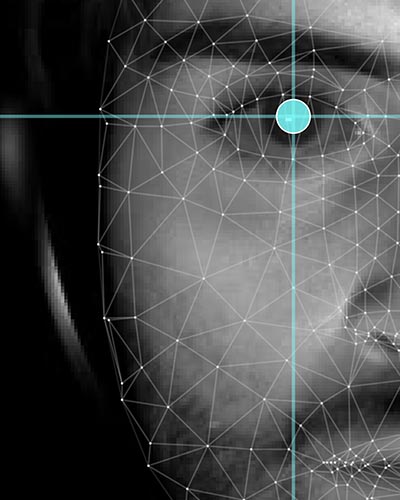Press ReleaseApril 30, 2025
New “Hidden in Plain Sight” Facial and Eye Biomarkers for Tinnitus Severity Could Unlock Path to Testing Treatments
Media Contact
Ryan Jaslow
Program Director, External Communications - Research, Mass General Brigham
rjaslow@mgb.org
Mass General Brigham research finds novel biomarkers for tinnitus that are reflective of nervous system’s “fight, flight, or freeze” response, and can be collected by filming patients while listening to unpleasant sounds
 Researchers at Mass General Brigham have identified new biomarkers for tinnitus by measuring pupil dilation and subtle facial movements that correlate with the level of distress caused by the disorder. Published in Science Translational Medicine, the findings could lead to placebo-controlled treatment studies that have largely been not feasible due to lack of objective measures.
Researchers at Mass General Brigham have identified new biomarkers for tinnitus by measuring pupil dilation and subtle facial movements that correlate with the level of distress caused by the disorder. Published in Science Translational Medicine, the findings could lead to placebo-controlled treatment studies that have largely been not feasible due to lack of objective measures.
“Imagine if cancer severity were determined by giving patients a questionnaire—this is the state of affairs for some common neurological disorders like tinnitus,” said corresponding author Daniel Polley, PhD, vice chair for basic science research and director of the Eaton-Peabody Laboratories at Mass Eye and Ear, a member of the Mass General Brigham healthcare system. “For the first time, we directly observed a signature of tinnitus severity. When we began this study, we didn’t know if sounds would elicit facial movements; so, to discover that these movements not only occur, but can provide the most informative measure to date of tinnitus distress, is quite surprising.”
Tinnitus presents as persistent phantom sounds like ringing, buzzing or clicking, that affect about 12% of the general population and 25% of individuals ages 65 and older. Though many learn to live with it and consider it a nuisance, an estimated 15% of sufferers have tinnitus so disabling that it disrupts sleep, mental health, and daily functioning. Until now, there’s been no objective way to differentiate these experiences.
In addition to more standard measures of hearing and auditory brain function, Dr. Polley and his team turned their attention more downstream to the sympathetic nervous system—the body’s “fight, flight, or freeze” mechanism—to look for outward, involuntary signs of distress in people with tinnitus that might be “hidden in plain sight.” They knew that the pupil dilation was a sign of increased arousal and that involuntary facial movements could provide a window into threat assessment.
The researchers hypothesized that people with debilitating tinnitus are chronically in vigilance mode, reacting to everyday sounds as if they are threats. To test this, they recruited 97 participants with normal hearing, which included 47 with varying levels of tinnitus and sound sensitivity and 50 healthy volunteers that served as controls.
Video recordings were made while participants listened to pleasant, neutral, or distressing and unpleasant sounds (like coughing fits, yelling, or a baby crying). Using artificial intelligence (AI)-powered software, they detected rapid and subtle involuntary facial movements—twitches in the cheeks, eyebrows, or nostrils—correlated with reported tinnitus distress levels. When combined with pupil dilation data, the predictive power increased even more.
In people with severe tinnitus, pupils dilated extra wide at all sounds (pleasant, neutral, or unpleasant), while facial movements were blunted in response to the same sounds. People without tinnitus or with less bothersome tinnitus by contrast showed exaggerated pupil dilation and facial movements only to the most unpleasant sounds. The measures also predicted individual questionnaire scores for hyperacusis severity (reduced sound tolerance), though the results were not as accurate as tinnitus severity.
“What’s really exciting is this vantage point into tinnitus severity didn’t require highly specialized brain scanners; instead, the approach was relatively low-tech.,” said Polley, who also is also director of Mass Eye and Ear’s Lauer Tinnitus Research Center. “If we can adapt this approach to consumer-grade electronics, they could be put to use in hearing health clinics, as objective measures in clinical trials and by the public at large.”
The study’s main limitation was its participant pool. To demonstrate the potential uses of their video-based approach, researchers had to exclude many individuals with co-occurring issues like hearing loss, advanced age, or mental health challenges, which are commonly associated with complex and severe tinnitus. Future research will aim to include these more at-risk populations.
Dr. Polley and his lab are now using these biomarkers to develop new therapies that combine neural stimulation with immersive software environments designed to eliminate or significantly reduce the loudness of the tinnitus phantom sound.
“These biomarkers get to the root of the distress,” said Dr. Polley. “While imaging might show hyperactive brain regions in tinnitus patients, these biomarkers reveal body-wide threat evaluation systems that are operating outside of their normal range, leading to the distressful symptoms they experience.”
Authorship: Additional Mass General Brigham authors include Samuel S. Smith, Kelly N. Jahn, Jenna A. Sugai, and Ken E. Hancock of Mass Eye and Ear’s Eaton-Peabody Laboratories.
Disclosures: Polley is on the advisory board of the American Tinnitus Association, Hyperacusis Research Ltd, and Tinnitus Quest. Jahn is on the advisory board of Hyperacusis Research Ltd and Hyperacusis Central.
Funding: This research was funded by the National Institute on Deafness and Other Communication Disorders grants P50DC015857 and K01DC019647, and a ASHFoundation New Investigators Research Grant.
Paper cited: Smith, et al. “Objective Autonomic Signatures of Tinnitus and Sound Sensitivity Disorders.” Science Translational Medicine, DOI: 10.1126/scitranslmed.adp1934

